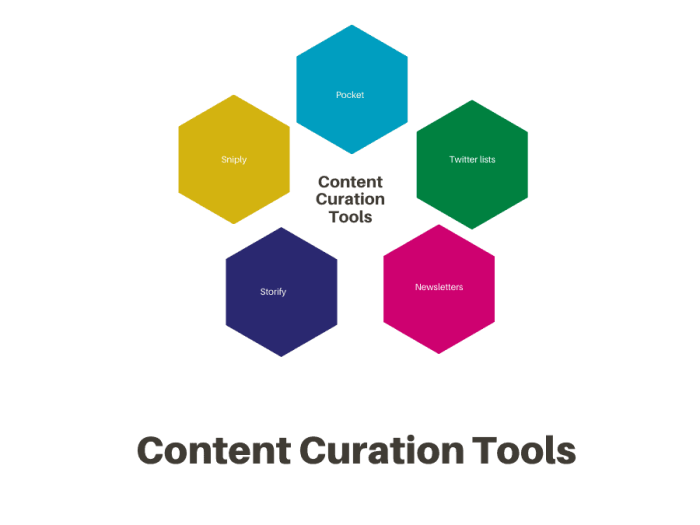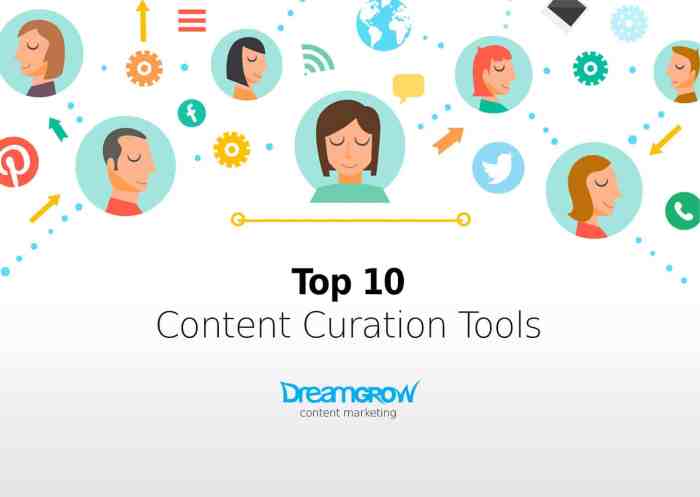Diving into Content Curation Tools, this intro sets the stage for exploring the world of curated content with a fresh and modern twist. From defining the tools to selecting the right one, get ready to up your content game!
Overview of Content Curation Tools
Content curation tools are essential resources used in content marketing to discover, gather, and share relevant content with a target audience. These tools help businesses sift through vast amounts of information available online to find the most valuable and engaging content to share with their followers.
Benefits of Using Content Curation Tools for Businesses
- Save Time: Content curation tools streamline the process of finding and organizing content, saving businesses valuable time.
- Build Authority: By consistently sharing high-quality curated content, businesses can establish themselves as industry experts and build credibility among their audience.
- Engage Audience: Curated content helps keep followers engaged and interested, leading to increased interaction and brand loyalty.
- Drive Traffic: Sharing curated content can drive more traffic to a business’s website or social media platforms, ultimately increasing conversions.
How Content Curation Tools Help in Organizing and Managing Curated Content Effectively
Content curation tools offer various features that aid in the organization and management of curated content. These tools provide functionalities such as content scheduling, categorization, and analytics to ensure that businesses can effectively manage their curated content strategy.
Types of Content Curation Tools

When it comes to content curation tools, there are various types available in the market catering to different needs and preferences of users. Let’s dive into the world of content curation tools and explore the options out there.
Automated Content Curation Tools
Automated content curation tools are designed to streamline the process of gathering and organizing content from various online sources automatically. These tools use algorithms to sift through massive amounts of data and present relevant content to users without much manual intervention.
- Feedly: Feedly is a popular automated content curation tool that allows users to aggregate content from their favorite websites, blogs, and news sources in one place. It offers customization options and AI-powered recommendations to deliver personalized content.
- Curata: Curata is another automated tool that helps users discover, curate, and share relevant content effortlessly. It uses machine learning to analyze content preferences and automate the curation process based on user interests.
Manual Curation Tools
Manual content curation tools, on the other hand, require human input and intervention to select, organize, and share content. While they may involve more time and effort compared to automated tools, manual curation allows for a more personalized touch and curated content tailored to specific audiences.
- Pocket: Pocket is a popular manual content curation tool that lets users save articles, videos, and other content from the web to read or share later. It offers tagging and categorization features for easy content organization.
- Flipboard: Flipboard is another manual curation tool that enables users to create personalized digital magazines by curating content from various sources. It allows for a visually engaging way to consume and share curated content.
How to Choose the Right Content Curation Tool

When it comes to selecting the perfect content curation tool for your business, there are several factors to consider to ensure you make the right choice. From customization and integration capabilities to scalability and user-friendliness, each aspect plays a crucial role in determining the effectiveness of the tool for your specific needs.
Factors to Consider When Selecting a Content Curation Tool
- Content Relevance: Look for a tool that can effectively filter and curate content that is relevant to your industry and target audience.
- Content Sources: Consider the variety of content sources the tool can access to ensure a diverse range of materials for curation.
- Content Organization: Evaluate how the tool organizes curated content to make it easily accessible and manageable for your team.
Importance of Customization and Integration Capabilities
- Customization: Opt for a tool that allows you to customize the curation process to align with your branding and messaging requirements.
- Integration: Choose a tool that seamlessly integrates with your existing systems and workflows for a smooth content curation experience.
- Automation: Look for tools that offer automation features to streamline the curation process and save time for your team.
Tips for Evaluating Scalability and User-Friendliness
- Scalability: Ensure the tool can grow with your business and accommodate increasing content curation needs as your company expands.
- User-Friendliness: Prioritize tools that are intuitive and easy to use, reducing the learning curve for your team members and maximizing productivity.
- Feedback: Gather feedback from current users of the tool to assess its performance, reliability, and ease of use before making a final decision.
Best Practices for Content Curation with Tools
When it comes to curating content using tools, there are certain best practices that can help you optimize your efforts and achieve better results. From selecting the right content curation tool to maintaining a consistent theme and voice, and leveraging analytics for optimization, here are some key steps to follow:
Steps for Curating Content with Tools:
- Identify Your Target Audience: Before you start curating content, it’s essential to understand your target audience’s preferences, interests, and needs.
- Select the Right Content Curation Tool: Choose a tool that aligns with your content goals and allows for easy content discovery, organization, and sharing.
- Curate High-Quality Content: Focus on sourcing and sharing relevant, high-quality content that adds value to your audience.
- Organize Content Effectively: Use categories, tags, and filters to organize curated content for easy navigation and consumption.
- Add Your Unique Perspective: Don’t just share content; provide your insights, opinions, and expertise to make curated content more engaging.
Significance of Consistent Theme and Voice:
Maintaining a consistent theme and voice throughout your curated content helps in establishing brand identity, building trust with your audience, and creating a cohesive content experience. Consistency in theme ensures that your content aligns with your brand values and messaging, while a consistent voice helps in creating a personal connection with your audience.
Role of Analytics and Reporting Features:
Analytics and reporting features in content curation tools play a crucial role in optimizing curated content. By tracking key metrics such as engagement, click-through rates, and social shares, you can gain valuable insights into what content resonates with your audience and make data-driven decisions to improve your curation strategy. These features help in identifying trends, understanding audience behavior, and refining your content curation efforts for better results.
